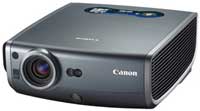Canon Rolls Out LCoS-Based Multimedia Projectors

Canon's REALiS WUX10 Mark II |
Canon this week launched two new high-resolution models in its REALiS line of LCoS-based multimedia projectors--the REALiS WUX10 Mark II and REALiS SX80 Mark II.
Both of the new models fall into Canon's REALiS projector line and use Canon-developed LCoS panels to eliminate the "screen door" effect experienced with standard LCD projectors. They also feature Canon's Aspectual Illumination System optical system, a 1.5x powered zoom/focus lens, and new lens coatings to reduce glare and ghosting. They also offer ±20 degree automatic and manual vertical keystone correction.
The WUX10 Mark II provides a resolution of 1,920 x 1,200 using a 0.71-inch LCoS reflective LCD panel, a contrast ratio of 1,000:1, a brightness of 3,200 ANSI lumens, and a 10-bit pixel depth. It's also a portable model, weighing in at 10.8 lbs. The WUX10 is expected to be available in October for a base price of $12,999.
The SX80 Mark II offers a resolution of 1,400 x 1,050 using a 0.55-inch LCoS reflective LCD panel, a contrast ratio of 900:1, and a brightness of 3,000 ANSI lumens. The SX80 also provides USB/PictBridge connectivity for delivering presentations from USB flash drives or PictBridge-enabled cameras. It weighs in at 11.5 lbs. and is shipping this month.
The REALiS WUX10 Mark II and REALiS SX80 Mark II are available now. The REALiS WUX10 Mark II sells for a base price of $12,999. The REALiS SX80 Mark II sells for $3,999. Models offering Dicom support are also expected to ship this month (the REALiS WUX10 Mark II and REALiS SX80 Mark II D). Further information is available here.